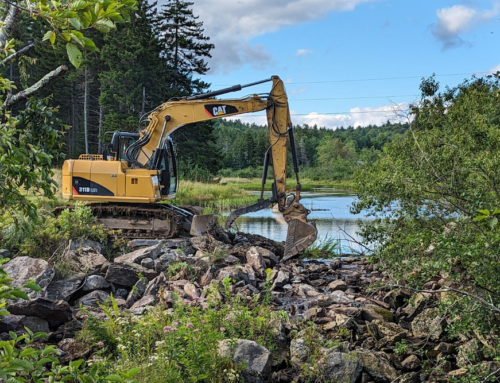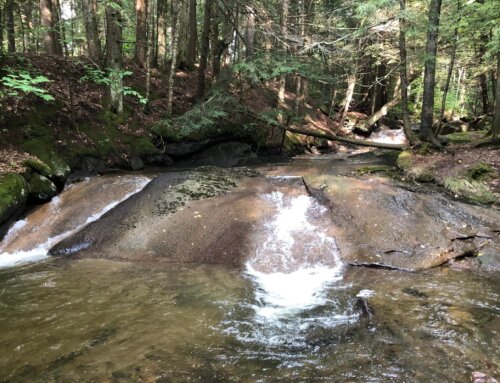As we begin the New Year and reflect on last year’s accomplishments, we are happy to share that Connecticut River Conservancy (CRC) completed over 18 river restoration projects throughout 4 states of the Connecticut River Watershed (NH, VT, MA, & CT) in 2022. From dam removals to tree planting we take a holistic approach to implementing initiatives that prioritize protecting clean water, restoring natural river flow, and improving wildlife habitat. Through CRC’s dedication to social impact, these initiatives further benefit local economies by purchasing from local plant nurseries and employing construction crews, seasonal planting teams, engineering and design firms, and others who help these projects to life.
“Restoration efforts for the Connecticut River and its tributaries are incredibly important for maintaining clean water and healthy habitat,” said Ron Rhodes, Interim Executive Director at CRC. “These projects create a long-lasting impact for both people and wildlife, and are made possible thanks to our donors and the incredible dedication of our team and partnerships throughout the four states of the Connective River basin. We look forward to continuing to build upon these accomplishments in 2023 and beyond.”
The river restoration projects completed by CRC in 2022 are:
- 3 dam removals: Including removing two remnant dams on the mainstem of the Connecticut in Guildhall, VT and Colebrook, NH and one obsolete dam on the Ompompanoosuc River in Post Mills/Thetford, VT.
- 1 floodplain forest project: Using an innovative approach to restore 10 acres of former hayfield to floodplain forest on the Johnson Farm Wildlife Management Area in Canaan, VT.
- 11 tree planting projects: Planting a total of 9,600 trees along rivers in 10 towns including Bath, Colebrook, Lisbon and Lyme, NH; Lyndon, Norwich, Townsend, West Windsor, and Windham, VT; as well as Hartford, CT.
- 3 projects for invasive species removal and prevention: Consisting of dozens of regional events throughout the summer months in Massachusetts and Connecticut.
The removal of the two remnant dams this year have eliminated hazards for boaters and paddlers using the Connecticut River Paddlers Trail or others recreating locally on the river. Removal of the obsolete mill dam opened 19 miles of river for the first time in 150 years by removing a barrier that prevented fish and other aquatic life to pass freely upstream. The floodplain forest project restored 10 acres of rare and specialized habitat that helps wildlife and allows floodwaters to slow and spread out naturally during storms. CRC’s tree planting projects across 21 acres will improve water quality and wildlife habitat along more than 8,100 feet of stream.
CRC is also partnering with State staff and others across the watershed to tackle aquatic invasive plants. Hydrilla (Hydrilla verticillata), considered the most destructive submerged aquatic invasive plant in many southern states, now threatens the ecological and economic viability of the Connecticut River. Hydrilla was first found in the Connecticut River in 2016. This season, CRC and partners used benthic barrier mats to suppress its growth at a site in Cromwell, CT. Benthic barriers are roughly 10x50ft mats placed on the river bottom in the spring and weighed down with rebar. They can be removed after 4-6 weeks and have been found to be an effective tool for managing the growth of hydrilla at specific sites.
Another aquatic invasive plant found in the watershed is water chestnut (Trapa natans). It is fast growing and quickly reproducing. If left unattended it will easily cover an entire waterbody with its rosettes. Each rosette can produce 15 to 20 seeds, which are viable for up to 12 years. Monitoring water chestnut spread annually is vital. Since 2019, CRC has taken the lead on the removal efforts for water chestnut in Connecticut and Massachusetts. This work couldn’t have been possible without 50 participating organizations, businesses, and agencies that collaborated with us. In 2022, the effort brought in 230 hard working volunteers to participate in water chestnut pulls in CT and MA. Together, over 2,110 person hours were contributed to the effort of removing 900,000 rosettes or 97,000 lbs. of water chestnut via hand pulling events led by volunteers, and mechanical removal events led by CRC and U.S. Fish and Wildlife Service.
CRC thanks our many partners Ammonoosuc Conservation Trust, Connecticut Agricultural Experimentation Station, Friends of Whalebone Cove, Intervale Conservation Nursery, Jonah Center for Earth and Art, New England Wetland Plants, Newbury Conservation Commission, Northwoods Stewardship Center, Passumpsic Valley Land Trust, Redstart Forestry, River Park Estates, Friends of the Silvio O. Conte Refuge and Friends of Fannie Stebbins Memorial Refuge, Chicopee 4Rivers, SWCA Environmental Consultants, Appalachian Mountain Club, Friends of Forge Pond, Broad Brook Coalition, Nashawannuck Pond Association, Beseck Lake Association, Massachusetts Aubuchon, MA Department of Conservation and Recreation, and private landowners; and funders including our generous CRC donors, City of Middletown, Community Foundation of Middlesex County, Department of Energy and Environmental Protection (CT DEEP), Hartford Foundation for Public Giving’s Sestero Fund, Holyoke Gas and Electric, National Fish and Wildlife Foundation, New Hampshire Charitable Foundation, One Tree Planted, PUR Project, USDA Natural Resources Conservation Service, US Fish and Wildlife Service, Vermont Agency of Natural Resources, Vermont Fish and Wildlife Department, and Watersheds United Vermont.
While these projects are examples of what CRC was able to implement this field season, the organization has many more in planning and design. All of these restoration projects require grant funding and multiple years of planning work to accomplish. If you are interested in exploring projects to enhance our rivers on your land, or supporting our overall work, don’t hesitate to reach out to CRC. Email restoration@ctriver.org.










